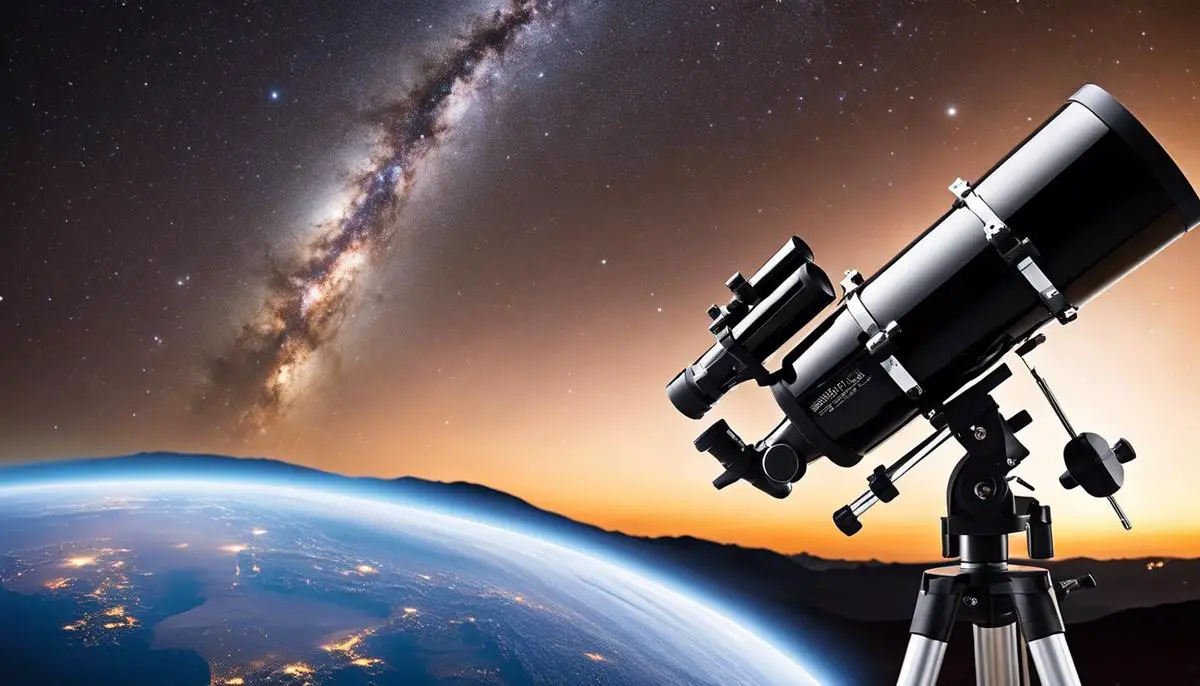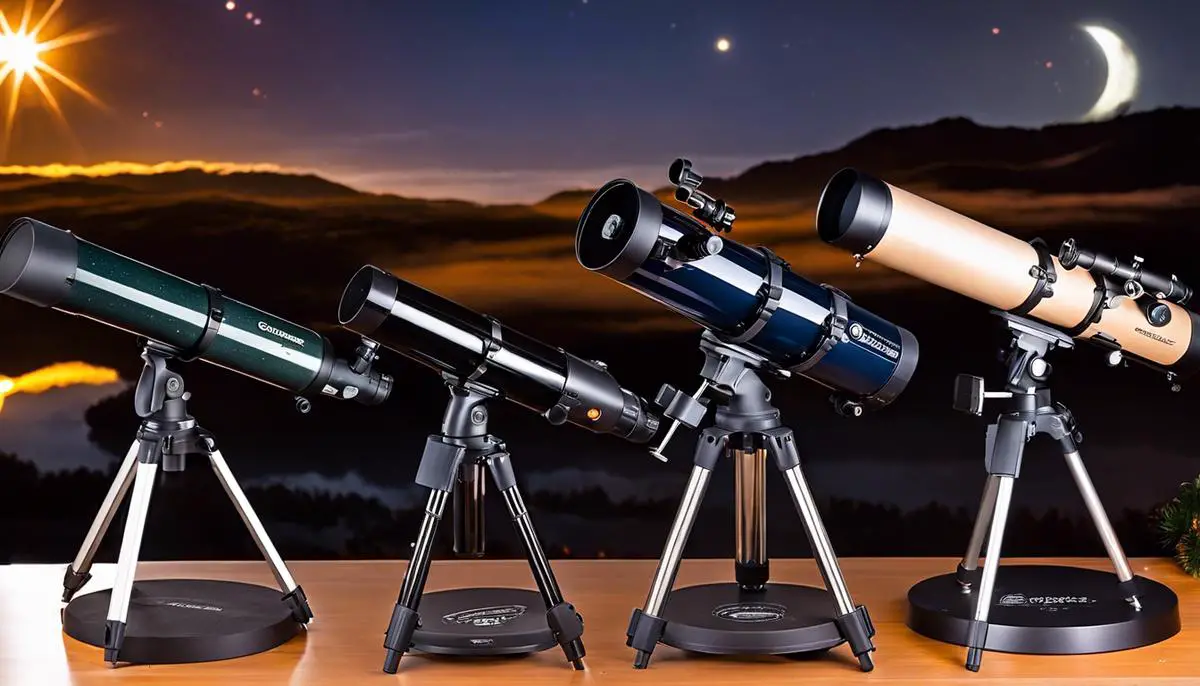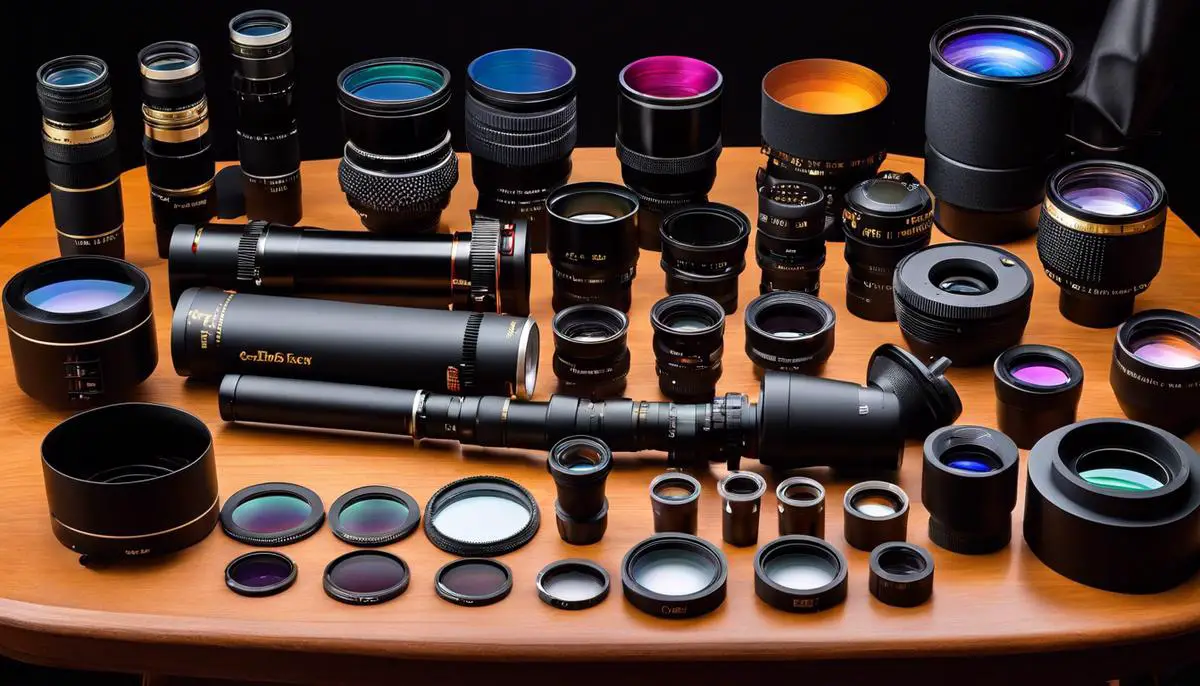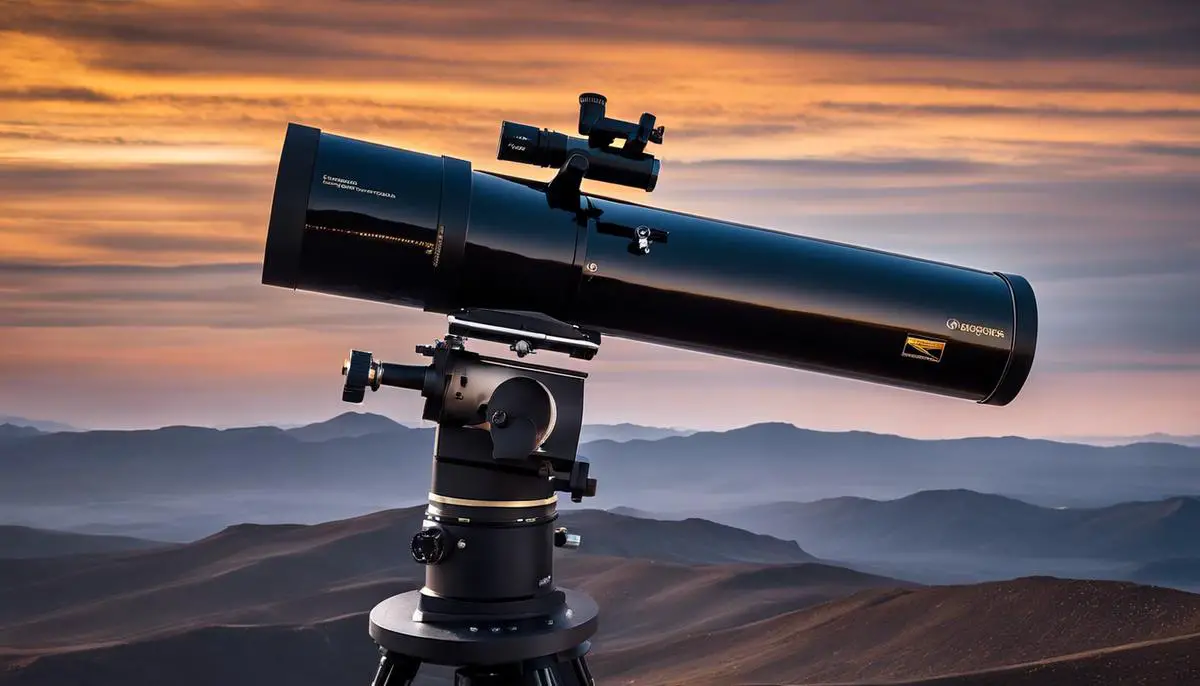Welcome to the exciting world of stargazing and celestial exploration! For a beginner this can be quite a thrilling journey, filled with astronomical discoveries and the sheer joy of understanding our universe a little better. But the first step to this adventure is selecting a suitable telescope, one that matches your interests, ease of use and budget. Our comprehensive guide here intends to simplify this decision-making process for you. We’ll go through crucial aspects such as the basics of telescopes, choosing your first telescope, recommended telescope models for beginners in 2023, telescope maintenance, and potential accessories and enhancements you might need alongside. So let’s embark on this astronomical adventure together!
Understanding Telescope Basics
“Telescopes: A Journey into the Cosmos”
One can scarcely deny the allure and mystique of the cosmos. The wide expanse of the universe, filled with myriad celestial bodies revolving in the darkness of space, is a spectacle that has intrigued mankind since antiquity. The telescope, an instrument of humanity’s quest to understand and unravel the secrets of the skies, serves as a gateway to this great cosmic theater. The intricate workings of the telescope are guided by certain fundamental principles relating to the science of optics, the understanding and manipulation of light.
Foremost, it is important to appreciate the nature of light. Light is composed of electromagnetic waves and travels at a speed of approximately 186,000 miles per second in a vacuum. When any segment of these waves encounters a surface, it is refracted, or bent, and the degree of refraction is determined by the composition and curvature of the said surface. It is this phenomenon of refraction that forms the bedrock principle for the functioning of a refractor telescope.
A refractor telescope consists of an objective lens and an eyepiece. The objective is a lens located at the forefront of the telescope. As light from the observed object enters the telescope, the objective lens refracts it. This refraction causes the parallel light beams to converge or meet at a focal point in the telescope barrel. From the focal point, the light then moves through the eyepiece, a lens that magnifies the image for the viewer.
Then come reflecting telescopes, underpinned by the principle that light can also reflect off surfaces. Here, a concave mirror replaces the objective lens. The mirror captures incoming light and reflects it back towards a focal point. The light, concentrated at the focal point, then travels through the eyepiece, magnifying the image for our viewing pleasure.
It is worth noting that the diameter of the objective lens or mirror (known as the aperture) plays a significant role in the performance of a telescope. Larger apertures allow more light to be captured, offering brighter and more detailed images. Moreover, the aperture also influences the telescope’s resolving power, its ability to clearly differentiate two closely located celestial bodies.
In conclusion, telescopes were designed to be humanity’s eyes into the cosmos that otherwise lay beyond our reach, functioning on the fundamental principles of how light behaves around lenses and mirrors. Understanding these principles demystifies the enchanting sights they bring into focus, from the craters of the moon to the distant galaxies. Indeed, it is a testament to our enduring curiosity about the broader universe and our place in it, a curiosity satisfied by these humble yet powerful instruments of astronomical observation.

Choosing Your First Telescope
When venturing into celestial observation, a beginner’s primary considerations should revolve around their goals, budget, and the type of observations they’d like to make, all critical aspects in determining which type of telescope to purchase.
Starting with one’s objectives is essential in determining the best telescope. For example, if the goal is to watch planets and their moons in detail, one should lean towards a telescope with high magnification. Typically, refractor telescopes with long focal length are suitable for this purpose. However, if the target includes nebulae and galaxies, then the focus should shift towards a telescope with larger aperture and lower magnification, which are characteristics of reflecting telescopes.
Budget cannot be overlooked. Telescopes, like many other forms of technology, exhibit a certain correlation between cost and quality, to a significant extent. More expensive telescopes typically offer larger apertures, better-quality lenses, or mirrors, more robust mounting systems, and a variety of features that can enhance the observing experience. However, a higher price doesn’t always guarantee a better experience for beginners. Many affordable telescopes provide a balance of quality, functionality, and ease-of-use, ideal for novice astronomers.
First-time telescope buyers should also focus on the type of observations they hope to make. For instance, individuals attempting to observe objects within our solar system, such as the moon or nearby planets, may find refractor telescopes to be more apt because they offer high contrast and sharp images. Conversely, for those intrigued by distant galaxies, nebulae, and star clusters, a reflecting telescope may be better due to its larger aperture and ability to observe more light.
The telescope type may have distinct outcomes, depending on the preferred observing location as well. Reflecting telescopes, for example, are excellent for dark-sky observing, but less optimized for use in urban settings besieged by light pollution – a problem that specifically affects the visibility of deep-sky objects.
Lasty, unlike the common perception, bigger does not always mean better when it comes to telescopes. While larger telescopes can gather more light and resolve finer detail, they also tend to be heavier, bulkier and more difficult to set up and transport. Consequently, an astronomer’s physical ability and dedication towards setup can dictate the practical size of a telescope – factors notably observed in Dobsonian telescopes, which provide large apertures at a modest cost but demand considerable setup time and transportation efforts.
In its essence, telescope selection is a task of delicately balancing goals, type of observation, budget, and practicality. Only by considering these elements, first-time buyers can embark on their exciting journey of star-gazing fruitfully, pushing the boundaries of human knowledge and satisfying their innate curiosity of the universe’s mysterious expanse.

Recommended Telescopes for Beginners in 2023
Selecting the most appropriate telescope model for beginners in 2023 requires careful deliberation, taking into account specific aspirations and constraints. Three of the most suitable models backed by credible scientific principles and user-friendly ergonomics include the Celestron AstroMaster 70AZ Refractor, the Orion SkyQuest XT6 Classic Dobsonian, and the Meade StarPro AZ 102mm Refractor.
Situated as a prime entry-point, the Celestron AstroMaster 70AZ Refractor offers a balance between price and performance. Notably, refractor telescopes are particularly effective for observing the surfaces of planets and their moons due to superior chromatic accuracy. This model features a 70mm objective lens, sufficient for a beginner to explore solar system bodies and bright deep-sky objects. Its alt-azimuth mount provides intuitive movement, scant of the complexities often associated with higher-end equatorial mounts.
Pivoting towards reflecting telescopes, the Orion SkyQuest XT6 Classic Dobsonian serves as a robust introductory option. Reflecting telescopes, owing to their larger apertures, excel at showcasing distant galaxies and nebulae. This model, carrying a sizable 152mm aperture, harbors considerable light-gathering capabilities transcending most beginner’s telescopes. The XT6 is equipped with a Dobsonian mount – a design easeful to cope with, simplifying the task of manually tracking celestial objects.
Veering back to refractors, the Meade StarPro AZ 102mm Refractor further elevates the beginner’s observing experience. Its larger 102mm objective lens fortifies the telescope with heightened resolution and brightness, extending the range of observable cosmic wonders. Like the AstroMaster 70AZ, this model also utilizes an alt-azimuth mount, prioritizing accessibility for the novice astronomer. Still, it attests to the notion that a higher budget provision corresponds to superior optical performance.
The observing location is a noteworthy determinant in telescope selection. Areas saturated with light pollution necessitate telescopes with larger apertures to enhance image brightness and contrast. Consequently, the Orion SkyQuest XT6 would be a fitting choice for urban stargazers, while the Celestron AstroMaster 70AZ and Meade StarPro AZ 102mm perform optimally under dark skies.
Lastly, beginners ought to consider the trade-offs between telescope size and practicality. A larger telescope, although possessing superior optical capabilities, may prove cumbersome and impede frequent use. Conversely, a compact model could limit observational potential but promote regular usage through convenience.
In summation, the process of selecting an ideal beginner telescope mandates a balance of personal astronomical goals, observation types, budgetary constraints, practicality, and observing locations. The Celestron AstroMaster 70AZ Refractor, Orion SkyQuest XT6 Classic Dobsonian, and Meade StarPro AZ 102mm Refractor, sit as distinct exemplars, fostering a profound appreciation for the cosmos through astronomy’s riveting gateway.

Maintenance and Care for Telescopes
Telescope Maintenance: Ensuring Longevity for Beginners
In the vast realm of amateur astronomy, owning a telescope is often the pinnacle of stargazing prowess. Having traversed the fascinating precepts of refractor and reflecting telescopes, along with gaining insights into how aperture size impacts the quality of celestial observation, it behooves one to master the art of telescope maintenance. Proper care not only ensures the longevity of these instruments of revelation but also optimizes their operational efficiency, guaranteeing premiere sightings of cosmic wonders.
To begin, a clean eyepiece is the window through which the cosmos unveils itself. Dirt or dust can severely cloud this window, tampering with the viewing experience. Therefore, a routine of meticulous cleaning should be established using specially designed lens cleaners and non-abrasive microfiber cloth, ensuring the eyepiece retains its pristine condition.
Following the eyepiece are the critical optics of the telescope including the objective lens or the primary mirror, depending upon the type of the instrument. They demand the utmost care in handling and cleaning. Overzealous cleaning efforts can inadvertently cause scratches or, in adverse scenarios, alter their delicately calibrated alignment. It is advisable to undertake any cleaning operations only when absolutely necessary and under expert guidance.
Furthermore, damp environmental conditions can extract their toll on the telescope owing to potential fungal growth. Therefore, it is recommended to store telescopes in a low-humidity environment after allowing them ample time to acclimatize and return to room temperature following cold night observations.
Continuing along this vein, it is crucial to ensure that telescopes are securely stored when not in use. Storage should ideally be a safe space away from traffic, excessive heat, and corrosive chemicals. Moreover, for reflecting telescopes, it is advisable to store the instrument vertically to minimize dust accumulation on the mirror.
Equally important is the maintenance of the mount. Mount adjustments should be kept smooth through regular checks for looser screws or inaccurate alignment. The mount’s stability is a key factor in precise observations, and its neglected upkeep can inflict ruinous effects on the viewing experience.
Last but not least, in matters of transportation, the telescope should be properly disassembled within a purpose-built, padded carry case whenever possible. The vibrations induced during transportation can disrupt optic alignments, hence making this step integral to prudent telescope upkeep.
The joy of uncovering the secrets of the universe through a private telescope is immensely gratifying. Therefore, it merits repeating that the regular and diligent maintenance of these gateway devices to the cosmos ensures their longevity and optimizes their performance. In the universal quest for understanding our place in the cosmos, a well-maintained telescope serves as our most faithful and reliable companion.

Telescope Accessories and Enhancements
Accessories and Enhancements for Telescopes: A Primer for Beginners
Equally essential as embarking upon the journey of celestial exploration by acquiring your first telescope, is being cognizant of the importance of suitable accessories and enhancements that can significantly propel your astronomical observations. This article will delve into practical, yet often overlooked, components that could prove essential to enhancing a beginner’s stargazing experience.
Foremost, Barlow lenses serve as an indispensable tool in the realm of telescope accessories. Essentially, this accessory magnifies the image without compromising on the comfortable eye relief supplied by the eyepiece, thereby enabling the observation of celestial bodies with greater detail. By doubling or tripling the power of your eyepieces, a 2x or 3x Barlow lens can be an economical alternative to purchasing additional eyepieces.
Following on, filters can play a significant role in refining the quality of observed celestial images. There exists a myriad of filter types, each designed to improve specific observation conditions like enhancing contrast, reducing glare, or highlighting specific planetary features. For instance, a moon filter can help mitigate the moon’s overall brightness, allowing for the display of finer details in the lunar landscape.
Additionally, the consideration of a motor drive is worthwhile, particularly for equatorial mounts. The gradual motion of stars across the night sky due to the Earth’s rotation may necessitate constant manual readjustment of your telescope. However, with the inclusion of a motor drive, the telescope could automatically track these movements, allowing for uninterrupted observations.
Piercing the veil of deep space often demands an added infusion of light beyond that offered by many beginner telescopes. An aperture mask, essentially a disc that restricts the outer areas of the telescope’s aperture, can be used in such situations. This accessory can assist in reducing optical aberrations and enhancing the overall image contrast.
Lastly, compasses and levels are instrumental in setting up your telescope accurately. While a compass guides the alignment towards the true north, in turn aiding precise tracking, a level ensures a balanced setup, thereby contributing to optimal functionality.
In essence, to fully harness the potential of your telescope, it’s indispensable to understand the vital role played by these supporting accessories. Adequate investment in these areas not only enriches the quality of your observations but also furthers your journey of unraveling the intricacies of the cosmos. Moreover, they ensure the longevity and sustained performance of your telescope, pivotal to your explorations of the awe-inspiring celestial tapestry. From Barlow lens to filters and motor drives, these accessories greatly enhance the telescopic experience, seamlessly bridging the gap between us and the celestial world.
Next, we explore versatile eyepieces and their impact on viewing celestial bodies…

As you reach the end of this guide, we hope that we’ve managed to illuminate the path for your star-gazing journey and made the choice of your first telescope a little easier and well-informed. Remember, it is not just about having the fanciest equipment, but rather how you use it and the joy of discovery it leads you to. Keep exploring, keep learning, for the universe is endlessly fascinating. And as with any new beginning, you’re bound to face some hurdles, but with time, patience and the right tools, there’s no limit to your celestial exploration. We wish you clear skies and unforgettable viewings!
![]()
